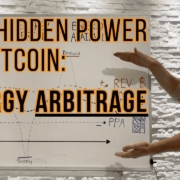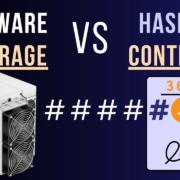Bitcoin: Mining ONE BLOCK 🟧⛏️ per day | Hashpower Academy
Ever wondered what it takes to mine one Bitcoin block per day?
In this video, we dive deep into the electricity and computational power required to achieve this feat. From hash rates to energy costs, we break down the essentials of Bitcoin mining and explore the broader Bitcoin ecosystem. Learn about the technology, economics, and strategies behind mining, plus insights into how public mining companies and treasury firms are navigating the crypto space. Whether you’re a crypto enthusiast, investor, or curious about Bitcoin’s future, this video is your guide to understanding the backbone of the blockchain!
Hashpower Academy Donations (Thank You!):
L1 Bitcoin: bc1qlgkc4pyrz22cykrx49cmuku3zyy2nuequu6r9y
L2 Lightning: academy@walletofsatoshi.com
Free Bitcoin Course! (Big Picture Basics):
https://www.hashpower.academy
I got my Bitcoin Mini-Miner from IXTech (10% off with code JAKE):
https://ixtech.xyz/?ref=JAKE
Align a meeting if you are looking to explore Mining/Hosting and other Business/Consultation Inquiries:
https://calendly.com/terahash/30min
Financial Disclaimer:
This video serves educational and informational purposes only and should not be construed as financial advice or investment recommendation. The views expressed are those of the presenter and do not represent Hashpower Academy’s official stance. Information is provided ‘as is’ without warranties, express or implied, as to its accuracy or completeness. Engaging with Bitcoin involves high risk, including potential financial loss, market volatility, and energy costs, and is suitable only for those who can bear these risks. Always conduct your own research and consult with a qualified financial or technical advisor before making decisions related to Bitcoin.
Video Transcript:
Hello there and welcome to the Hash Power Academy, your place to learn anything to do with Bitcoin. The topic of today’s video is understanding what it costs in electricity and hash rate and how much you earn in Bitcoin by mining one block per day. Wouldn’t that be interesting? So, first and foremost, let’s understand that there is 144 blocks distributed to the entire network per day. Now to be one of those you need to represent 144th and the cost in that is quite lengthy. The first thing to understand is why is there 144 blocks a day? Well, the network and the blockchain in of itself is also referred to as the time chain because the Bitcoin software is trying to regulate the amount of time and keep it constrained to about 10 minutes. Why? Because the amount of hash rate of all the different miners coming online, producing and finding blocks, adding it to the chain, well, it’s not exactly 10 minutes. And so that difference, that change that if blocks get faster and less than 10 minutes or slower, more than 10 minutes, that the network looks back 2016 blocks, two weeks roughly, to approximate how long did that two week period get shortened to or lengthened to. And if it gets shorter, difficulty increases. So the regulation of 144 blocks per day is what the software is trying to do no matter how big the network gets. And so to understand how much you’re getting by producing one block a day, let’s understand all the different pieces. So 144 blocks approximates to about 450 Bitcoin of subsidy. Now this is the key easy one. 3.125 subsidy per block. That’s the easy one, right? Next one down. So 144 and you represent one of those blocks. The network hash rate I’ve used a,000 xahash because by the time you could get enough hash rate to mine a whole block, the network’s probably going to be bigger because it’s always growing and the difficulty is always increasing. And the easy numbers here is that you can divide a,00 x a hash by 144 because we’re just representing one and it’s 6.94 or something like that. Let’s round it seven. So you need seven xahash of hash rate online racked and hashing to produce one block per day with a th00and xahash network which is 144. Now 7 x aash represents 7 million terraash. That’s a lot of hash rate. It’s a lot of heat as well. And there is a conversion with those computers. So to understand how much energy we would need as well. Well, we can divide sorry we can multiply the amount of hash rate by the efficiency. Now megaww per xahash is the same as jewels per terahash. It’s just bringing the numbers down by a factor on both sides. So, it’s a multiplier here and that gives us I’ve prepared the numbers quite easily. 7 * 14.28 is 100 megaww. And here’s where it gets interesting. If a very large hydropower station produces about 100 megawatts of power and one block can be mined with 100 megawws of power. It means that the network right now at scale is about 144 hydro power stations in terms of power source. That’s a good little way of sort of comprehending the scale of this system. 144 100 megawatt power stations and that’s using this efficiency. The average efficiency of the network is still closer to 20. So it’s a lot more power in a sense. And so we’re transitionally going to see more efficient compute come up come online over time. That’s what kicks off the old machines of the network or distributes them more more locally to more rural communities as such. But yeah, this is a an interesting way to sort of work your way through the commodity chain of electricity, hash rate, and bitcoin with your one single block example. If you want to scale to the size of a 100 megawatt site producing 7 million terraash to mine your one block and earn 3.125 Bitcoin per day in this 4-year period. Well, these are the numbers that you need. Thank you for listening. I hope you enjoyed and I’ll see you in the next video. Goodbye.














Leave a Reply
Want to join the discussion?Feel free to contribute!